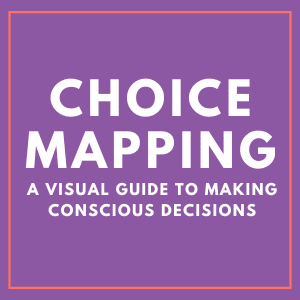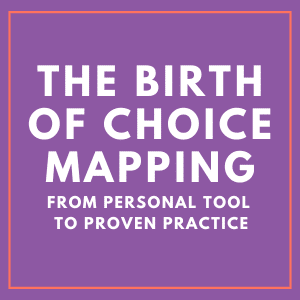When I first began working with Choice Mapping, my book editor asked me to explain how to create a map. The suggestion took me by surprise—I’d been creating maps instinctively for years without considering that others might want to learn the process. Yet that simple request led me to understand something essential about bringing clarity to our choices—something I’d been doing naturally but had never put into words.
The Distinction That Makes a Difference
You might be wondering how mapping differs from journaling. I see this question light up in people’s eyes whenever I introduce Choice Mapping. They often tell me, “But I already journal about my decisions.” And they’re right—journaling is a beautiful practice for processing thoughts and feelings. When you journal, your words flow freely onto the page, carrying emotions, insights, and possibilities along with them.
Choice Mapping offers something different. Instead of that free-flowing river of words, mapping creates a focused dialogue with yourself through pointed questions and concise answers. Think of it like having a conversation with a trusted mentor who knows exactly what questions to ask to help you find clarity.
Clarity Through Structure
Let me share what this looks like in practice. Recently, I worked with Elena, who came to me feeling overwhelmed about a career transition. Her journal was filled with pages of thoughtful exploration about this choice. But when she created her first map, something shifted. The visual structure helped her see patterns she’d missed in her journal entries.
“I thought I needed to write more to find clarity,” she told me. “But mapping showed me how to capture what matters most in a way I can actually see and use.”

Finding Your Truth
What I love most about mapping is how it helps you distill complex thoughts into clear, resonant statements. Each branch of your map becomes a nugget of truth about your choice. There’s something powerful about seeing these truths laid out visually—patterns emerge that might stay hidden in pages of narrative writing.
I watched this unfold beautifully with Mark, who’d been journaling about starting his own business for months. His journals captured his excitement, fears, and endless questions. When we created his first map, he placed “I choose to explore starting my business” at the center. As we added branches exploring why this choice mattered, what fears were present, and what possibilities excited him, his eyes lit up. “I can actually see my decision now,” he said. “It’s not just swirling in my head anymore.”
Making Mapping Part of Your Day
While journaling often requires dedicated time, Choice Mapping can fit naturally into your daily rhythm. I learned this from Rachel, a busy executive who thought she didn’t have time for another practice. “I started with just five minutes each morning,” she told me. “I’d map one choice while drinking my coffee. Those few minutes changed how I approached my entire day.”
This five-minute mapping practice has become one of my favorite tools to share. You choose one decision you’re facing, set a timer, and let your map grow organically for those few minutes. The time constraint often cuts through overthinking, helping you access your natural wisdom more directly.
Some clients keep mapping supplies—paper and pen, sticky notes, or a digital device—readily available for these quick mapping moments. Others schedule short mapping sessions between meetings or right before important decisions. The key isn’t perfection or length—it’s creating space to see your choices more clearly, even if just for a few minutes.
Bringing Both Practices Together
I want to be clear—this isn’t about choosing between journaling and mapping. They serve different yet complementary purposes in understanding yourself and your choices. Your journal provides that essential space for emotional expression and processing. It’s where you can pour out your heart, explore your feelings, and let your thoughts wander freely.
Choice Mapping steps in when you’re ready to bring structure to those explorations. It helps you organize insights, see patterns, and create a clear picture of your choice. Think of it like having both a comfortable couch for heart-to-heart conversations (journaling) and a well-lit desk for making plans (mapping).
Creating Space for Both Practices
One of my clients put it perfectly. After several mapping sessions, she said, “My journal is where I process everything. But my maps? They’re where I find clarity. I need both.”
Some clients use their journal first, letting thoughts and feelings flow freely. Then they turn to mapping to organize key insights and see the bigger picture. Others start with a map to get clear about what matters most, then use their journal to explore emotions that arise. There’s no single right way—what matters is finding the rhythm that works for you.
Daily Clarity Through Combined Practice
Think of journaling and mapping as complementary tools in your daily decision-making toolkit. Your journal might capture your morning thoughts about a challenging situation. Later, a five-minute map could help you see patterns in those thoughts, bringing structure to your reflections.
I watched this work beautifully for Marcus, who used his journal for emotional processing but found himself getting stuck in circular thinking. Adding brief mapping sessions helped him move from processing to clarity. “Journaling helps me feel my way through decisions,” he shared. “Mapping helps me see my way through them.”
Your Path to Clarity
What I’ve discovered through years of working with both practices is this: the path to clarity opens differently for each person. Your way of combining journaling and mapping will be as unique as you are. The key is remaining curious about what helps you access your inner knowing and make choices with greater confidence.
In the Choice Mapping series below, I share specific mapping techniques and practices. For now, notice what draws you forward. The path to conscious choice-making opens differently for each person. Your way of exploring will be as unique as you are. Discover the origin story of Choice Mapping and learn how to create your first map.
Deepen Your Choice Mapping Practice
Get your copy of The Book of Choice or explore mapping hands-on in my free interactive workshop: The Creative Art of Choice Mapping.








